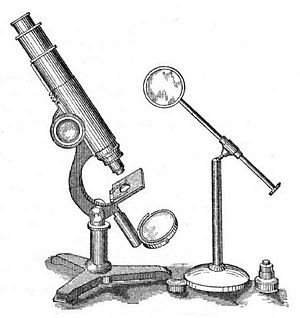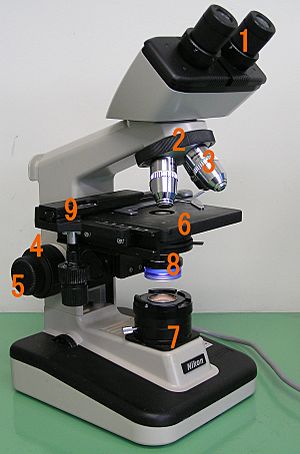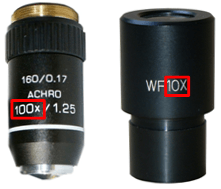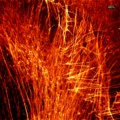Light microscope facts for kids
A light microscope is a cool tool that helps us see tiny things up close. Think of it like a super-powered magnifying glass! It uses light and special lenses to make small objects look much bigger.
When you want to look at something, like a tiny organism or a cell, you place it on a thin piece of glass called a slide. This slide sits on a flat part of the microscope called the stage. Clips hold the slide still.
Light from below the stage shines up through the object. This light then passes through a series of lenses. The first set of lenses, called objective lenses, makes the image bigger. Then, the light goes through the eyepiece lenses, which make the image even larger for your eye to see. Some modern light microscopes are actually digital cameras that take pictures of tiny things instead of having an eyepiece.
Many microscopes you might use in high school can magnify things 40 times (written as 40x). Some can even magnify hundreds or thousands of times! This lets scientists and students see amazing details, like the basic parts of cells.
Contents
What are the Main Parts of a Light Microscope?
Most light microscopes that use light shining through a sample have similar main parts. Here are the important pieces and what they do:
- Eyepiece (1): This is where you look! It has lenses that make the image even bigger.
- Revolving Nosepiece (2): This is a spinning part that holds different objective lenses. You can turn it to choose how much you want to magnify your sample.
- Objective Lenses (3): These are the main magnifying lenses, usually found right above your sample. They come in different strengths, like 4x, 10x, or 40x.
- Focus Wheels (4 & 5): These knobs help you make the image clear and sharp. The big wheel (4) is for big adjustments, and the small wheel (5) is for tiny, fine adjustments.
- Frame (6): This is the main body of the microscope that holds all the parts together.
- Light Source (7): This is usually a light bulb or a mirror that sends light up through your sample.
- Diaphragm and Condenser Lens (8): These parts control how much light shines on your sample and help focus the light evenly.
- Stage (9): This is the flat platform where you place your slide with the sample.
These parts are numbered to match the picture on the right, helping you see where everything is!
Why Can't Optical Microscopes See Everything?
Light microscopes are great, but they have a limit. They can't see things that are smaller than the light waves themselves. This is because of something called the "diffraction limit." Imagine trying to draw a tiny dot with a very thick marker – you just can't make it small enough!
Because of this limit, scientists use other types of microscopes to see extremely tiny things. These include:
- Atomic force microscope (AFM)
- Scanning electron microscope (SEM)
- Transmission electron microscopy (TEM)
- X-ray microscope
These special microscopes use different ways, like electrons or forces, to "see" things that light can't show us.
Images for kids
-
Scientists use optical microscopes to examine growing cells.
-
U.S. CBP agent checking a travel document at an international airport using a stereo microscope.
-
The diffraction limit set in stone on a monument for Ernst Abbe.
-
Dark field illumination, where contrast comes from light scattered by the sample.
-
Phase contrast illumination, where contrast comes from interference of light passing through different parts of the sample.
See also
 In Spanish: Microscopio óptico para niños
In Spanish: Microscopio óptico para niños

















